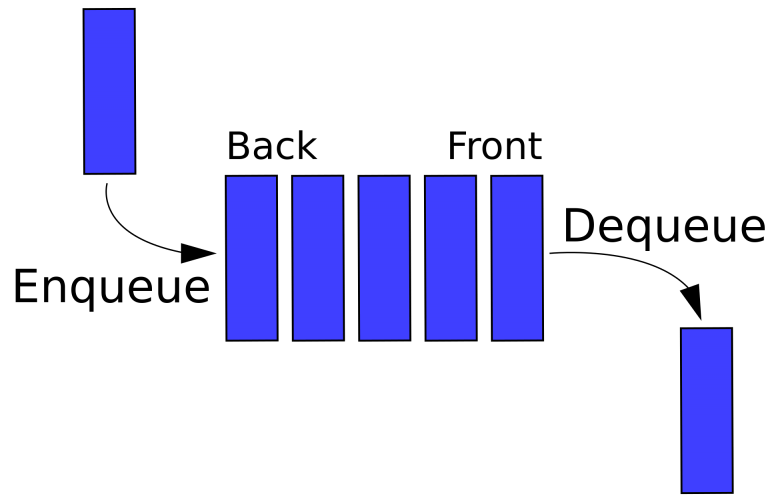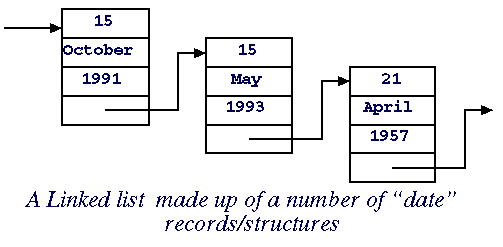C Program To Implement Stack Using Two Queues
Stack abstract data type Wikipedia. Simple representation of a stack runtime with push and pop operations. In computer science, a stack is an abstract data type that serves as a collection of elements, with two principal operations push, which adds an element to the collection, andpop, which removes the most recently added element that was not yet removed. The order in which elements come off a stack gives rise to its alternative name, LIFO last in, first out. Additionally, a peek operation may give access to the top without modifying the stack. The name stack for this type of structure comes from the analogy to a set of physical items stacked on top of each other, which makes it easy to take an item off the top of the stack, while getting to an item deeper in the stack may require taking off multiple other items first. Considered as a linear data structure, or more abstractly a sequential collection, the push and pop operations occur only at one end of the structure, referred to as the top of the stack. This makes it possible to implement a stack as a singly linked list and a pointer to the top element. A stack may be implemented to have a bounded capacity. If the stack is full and does not contain enough space to accept an entity to be pushed, the stack is then considered to be in an overflow state. SQT6Pp8dPbE/UouyT2LCZvI/AAAAAAAAA0g/fZ1e_PfvVlY/s1600/program+for+doubly+linked+list+in+C++.png' alt='C Program To Implement Stack Using Two Queues' title='C Program To Implement Stack Using Two Queues' />The pop operation removes an item from the top of the stack. HistoryeditStacks entered the computer science literature in 1. Alan M. Turing used the terms bury and unbury as a means of calling and returning from subroutines. Subroutines had already been implemented in Konrad Zuses Z4 in 1. Klaus Samelson and Friedrich L. Bauer of Technical University Munich proposed the idea in 1. March 1. 98. 8 Bauer received the Computer Pioneer Award for the invention of the stack principle. The same concept was developed, independently, by the Australian Charles Leonard Hamblin in the first half of 1. Stacks are often described by analogy to a spring loaded stack of plates in a cafeteria. Clean plates are placed on top of the stack, pushing down any already there. View2/2/h/300/interlace/1' alt='C Program To Implement Stack Using Two Queues' title='C Program To Implement Stack Using Two Queues' />When a plate is removed from the stack, the one below it pops up to become the new top. Non essential operationseditIn many implementations, a stack has more operations than push and pop. An example is top of stack, or peek, which observes the top most element without removing it from the stack. Since this can be done with a pop and a push with the same data, it is not essential. An underflow condition can occur in the stack top operation if the stack is empty, the same as pop. Also, implementations often have a function which just returns whether the stack is empty. Software stackseditImplementationeditA stack can be easily implemented either through an array or a linked list. What identifies the data structure as a stack in either case is not the implementation but the interface the user is only allowed to pop or push items onto the array or linked list, with few other helper operations. We are given queue data structure, the task is to implement stack using only given queue data structure. We have discussed a solution that uses two queues. Bu 353 Driver Windows 10 more. A stack can be implemented using two queues. Let stack to be implemented be s and queues used to implement be q1 and q2. Stack s can be. The following will demonstrate both implementations, using pseudocode. An array can be used to implement a bounded stack, as follows. The first element usually at the zero offset is the bottom, resulting in array0 being the first element pushed onto the stack and the last element popped off. The program must keep track of the size length of the stack, using a variable top that records the number of items pushed so far, therefore pointing to the place in the array where the next element is to be inserted assuming a zero based index convention. Thus, the stack itself can be effectively implemented as a three element structure structure stack. The push operation adds an element and increments the top index, after checking for overflow procedure pushstk stack, x item. Similarly, pop decrements the top index after checking for underflow, and returns the item that was previously the top one procedure popstk stack. Using a dynamic array, it is possible to implement a stack that can grow or shrink as much as needed. The size of the stack is simply the size of the dynamic array, which is a very efficient implementation of a stack since adding items to or removing items from the end of a dynamic array requires amortized O1 time. Linked listeditAnother option for implementing stacks is to use a singly linked list. A stack is then a pointer to the head of the list, with perhaps a counter to keep track of the size of the list structure frame. Pushing and popping items happens at the head of the list overflow is not possible in this implementation unless memory is exhausted procedure pushstk stack, x item. Stacks and programming languageseditSome languages, such as Perl, LISP and Python, make the stack operations push and pop available on their standard listarray types. Some languages, notably those in the Forth family including Post. Script, are designed around language defined stacks that are directly visible to and manipulated by the programmer. The following is an example of manipulating a stack in Common Lisp is the Lisp interpreters prompt lines not starting with are the interpreters responses to expressions setfstacklistabc set the variable stackABC popstack get top leftmost element, should modify the stack. A stack check the value of stackBC pushnewstack push a new top onto the stackNEWBCSeveral of the C Standard Library container types have pushback and popback operations with LIFO semantics additionally, the stack template class adapts existing containers to provide a restricted API with only pushpop operations. PHP has an Spl. Stack class. Dc Unlocker 2 Client Crack Version on this page. Vodafone Call Details Software there. Javas library contains a Stack class that is a specialization of Vector. Following is an example program in Java language, using that class. Stack. DemopublicstaticvoidmainStringargsStacklt String stacknew. Stacklt String stack. A Insert A in the stackstack. B Insert B in the stackstack. C Insert C in the stackstack. D Insert D in the stack. System. out. printlnstack. APPLICATION NOTE AT04055 Using the lwIP Network Stack Atmel SAM4E Introduction This application note aims at describing and understanding the lwIP stack, in order to. Generics cater many of the benefits of strongly typed collections as well as provide higher quality and performance boost code. This section covers C programming examples on Stacks Queues. Every example program includes the description of the program, C code as well as output of the program. The types needed are enumerated, yes. Theres only about six of them and that will never change. But the queues that hold the items must be able to hold all six types. YogLU8KL35I/TL0yG_HHRJI/AAAAAAAAD-A/fjrsr43a4eM/s1600/Untitled1.png' alt='C Program To Implement Stack Using Two Queues' title='C Program To Implement Stack Using Two Queues' />
 Prints the top of the stack Dstack. Dstack. pop removing the next top CHardware stackseditA common use of stacks at the architecture level is as a means of allocating and accessing memory. Basic architecture of a stackedit. A typical stack, storing local data and call information for nested procedure calls not necessarily nested procedures. This stack grows downward from its origin. The stack pointer points to the current topmost datum on the stack. A push operation decrements the pointer and copies the data to the stack a pop operation copies data from the stack and then increments the pointer. Each procedure called in the program stores procedure return information in yellow and local data in other colors by pushing them onto the stack. This type of stack implementation is extremely common, but it is vulnerable to buffer overflow attacks see the text. A typical stack is an area of computer memory with a fixed origin and a variable size. Initially the size of the stack is zero. A stack pointer, usually in the form of a hardware register, points to the most recently referenced location on the stack when the stack has a size of zero, the stack pointer points to the origin of the stack.
Prints the top of the stack Dstack. Dstack. pop removing the next top CHardware stackseditA common use of stacks at the architecture level is as a means of allocating and accessing memory. Basic architecture of a stackedit. A typical stack, storing local data and call information for nested procedure calls not necessarily nested procedures. This stack grows downward from its origin. The stack pointer points to the current topmost datum on the stack. A push operation decrements the pointer and copies the data to the stack a pop operation copies data from the stack and then increments the pointer. Each procedure called in the program stores procedure return information in yellow and local data in other colors by pushing them onto the stack. This type of stack implementation is extremely common, but it is vulnerable to buffer overflow attacks see the text. A typical stack is an area of computer memory with a fixed origin and a variable size. Initially the size of the stack is zero. A stack pointer, usually in the form of a hardware register, points to the most recently referenced location on the stack when the stack has a size of zero, the stack pointer points to the origin of the stack.